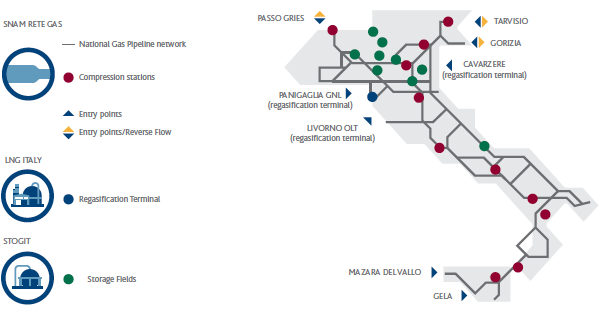Snam and the national gas infrastructure
Snam’s domestic network of pipelines moves gas from the system entry points and domestic production areas to points connected to the regional transportation network and storage facilities.
Snam’s regional transportation network, made up of the remaining section of pipelines, makes it possible to move natural gas in defined territorial areas, usually on a regional scale, to supply gas to industrial and thermoelectric consumers and urban distribution networks.
In Italy, Snam is responsible for the natural gas transportation, dispatching and storage business segments and the regasification of liquefied natural gas, making the necessary capacity to deal with market demand available and satisfy the requests submitted by shippers (network users) through the use and development of its own transportation network.
Snam makes use of an integrated infrastructure system made up of 32,508 km of methane pipelines, 11 compression stations, 9 storage fields and a regasification plant, as well as a dispatch centre for transportation and one for storage.
The natural gas introduced into the national network originates from imports and, to a lesser extent, national production. The gas from abroad is injected into the national network via eight entry points where the network joins up with the import methane pipelines (Tarvisio, Gorizia, Gries Pass, Mazara del Vallo and Gela) and with the LNG regasification terminals (Panigaglia, Cavarzere and Livorno). Domestically produced gas is introduced into the Network through 53 entry points from the production fields or their collection and treatment centres; the gas storage fields are also connected to the network.
WE MAKE THE AIR CLEANER
Air pollution is a major problem also in Italy. EU regulations set targets for reducing emissions, which will require a major development of alternative fuels and the replacement of older, more polluting vehicles. A simple, rapid and economic solution is to use natural gas or methane for vehicles (CNG - compressed natural gas).
Natural gas, the "greenest" fossil fuel
The use of methane instead of traditional fuels (petrol and diesel) reduces CO2 (carbon dioxide) emissions by approximately 40%. This gas is responsible for the “greenhouse effect” and global warming, approximately 94% of NOx (nitrogen oxides), which cause “acid raid”, and as much as 95% of PM (particulate matter) emissions, which are most harmful to our health.
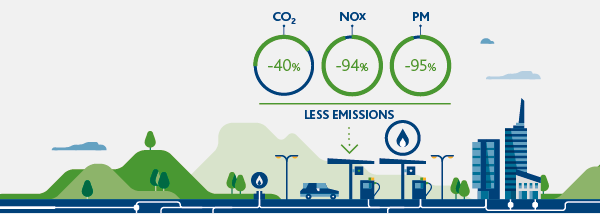
SAFE, RELIABLE AND READILY AVAILABLE TECHNOLOGY
A greater dissemination of natural gas may not be long in coming, given the spread of gas network infrastructure and the high-level of technological know-how achieved in Italy. The technology is safe and extremely reliable. Its development would also have significant positive effects on both national employment and the economy (€1.5 billion for natural gas technology and over €1 billion for natural gas distribution infrastructure in Italy).
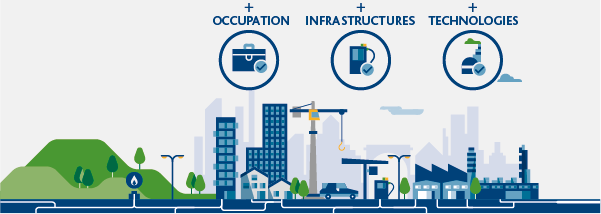
TRIPLING THE NUMBER OF NATURAL GAS VEHICLES
To improve the current situation, a first step could be to replace two million traditionally-fuelled vehicles (approximately 6% of vehicles circulating in Italy) with natural gas vehicles.This would amount to three million natural gas-fuelled vehicles (there are currently one million), with a reduction – calculated based on the total fleet of vehicles – of 4% CO2, 10% NOx and 12% PM.
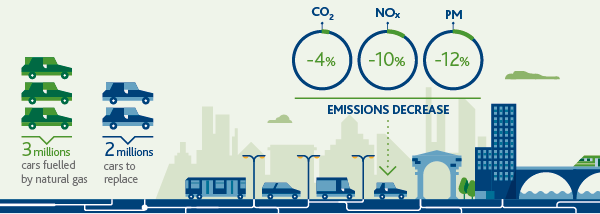
SNAM'S COMMITTMENT
To increase the number of natural gas vehicles, it is necessary to act mainly on the number of fuel stations, which currently stands at approximately 1,100 in Italy, unevenly distributed in the various regions. Snam, over the next five years, will invest approximately €150 million to promote the development of facilities for the supply of natural gas. The aim, within a decade, is to double the number of service stations, with a more balanced distribution throughout Italy. This will promote the development of the circulating fleet of both light and heavy vehicles.
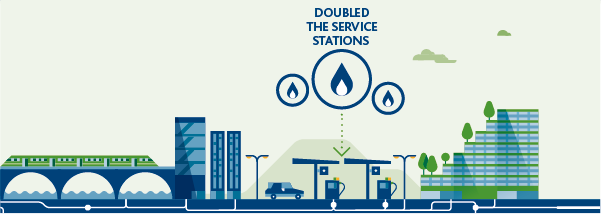
A FINANCIAL SAVING FOR ALL
In addition to the environmental benefits, financial advantages are also gained. The cost of natural gas is, in fact, much lower than that of petrol and diesel. Furthermore, it is more efficient: one kilogram of natural gas enables you to travel more kilometres than one litre of petrol. An increase of up to three million in the circulating fleet of natural gas vehicles would save Italian families and businesses up to €800 million in five years.
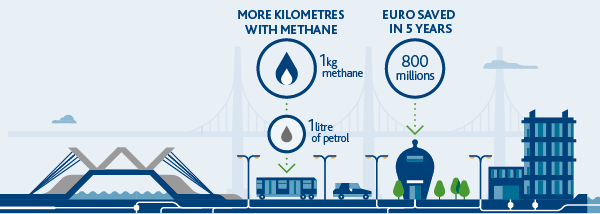
A CHOICE PROJECTED INTO THE FUTURE
Equipping our country with the infrastructure and technology needed to use natural gas may lead to even greater advantages in the near future. They could become a platform for the development of renewable sources, such as biomethane, a fuel with an environmental footprint similar to that of electricity. They could also promote an increased domestic production of natural gas, with positive effects on the agriculture and food sector, as biomethane is also obtained from the processing of agricultural and agro-industrial by-products.

GRI-G4:6
